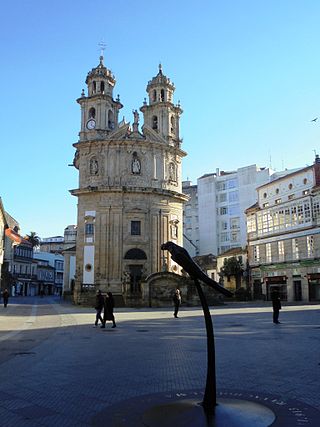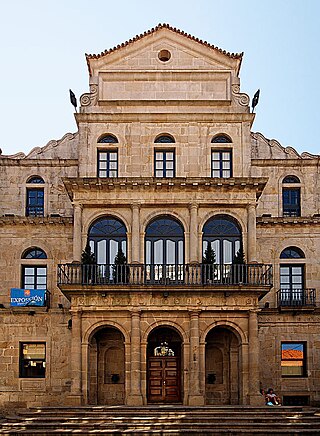
Alberto Núñez Feijóo is a Spanish People's Party politician who serves as Member of the Congress of Deputies and as president of the People's Party. He served as the President of the Autonomous Government of Galicia from 2009 to 2022. Feijóo was appointed government formateur following the 2023 election, however his investiture ultimately failed.

The 2012 Galician regional election was held on Sunday, 21 October 2012, to elect the 9th Parliament of the autonomous community of Galicia. All 75 seats in the Parliament were up for election. The election was held simultaneously with a regional election in the Basque Country.

The 2016 Galician regional election was held on Sunday, 25 September 2016, to elect the 10th Parliament of the autonomous community of Galicia. All 75 seats in the Parliament were up for election. The election was held simultaneously with a regional election in the Basque Country.

The 2020 Galician regional election was held on Sunday, 12 July 2020, to elect the 11th Parliament of the autonomous community of Galicia. All 75 seats in the Parliament were up for election. The election was initially scheduled for 5 April 2020 but was postponed as a result of the COVID-19 pandemic. It was held simultaneously with a regional election in the Basque Country.
Néboa is a Spanish mystery-thriller television series starring Emma Suárez and Isabel Naveira. Created by Xosé Morais, Víctor Sierra and Alberto Guntín, produced by RTVE and Voz Audiovisual and set in Galicia, the plot concerns the investigation on a series of serial murders taking place in a small island community during the carnival. It aired on La 1 in 2020.

The church of the Pilgrim Virgin is a scallop-shaped Roman Catholic chapel located in the city of Pontevedra, in Spain, along the route of the Portuguese Way of St. James.

The Pontevedra Museum is a museum in the Galician city of Pontevedra in Spain. It was founded by the Provincial Deputation of Pontevedra on 30 December 1927 and has six buildings for its exhibitions. It has permanent and temporary exhibition rooms. The museum's collections are multidisciplinary, classified into rooms for painting, sculpture, archaeology, decorative arts, engraving and ethnography.

The Monument to the Tertulia, known as the Literary Circle in Modern Coffee, is a sculptural group created by the Spanish sculptor César Lombera, in Pontevedra (Spain). It is located in Saint Joseph's Square in front of the Café Moderno and the central building of the former Provincial Savings Bank of Pontevedra and was inaugurated on 13 January 2006.

The Praza da Ferrería is a large square located on the edge of the old town of Pontevedra (Spain), inside the old city walls. It is the main square of the old town and has an area of about 2,000 m2. It includes the small squares of the Estrella on the north side, the Orense square on the south side and the Casto Sampedro square on the east side, making a total of almost 5,000 m2.

The Café Moderno is an art nouveau and eclectic building located in St. Joseph's Square in Pontevedra, Spain. It is the building with the most important Art Nouveau interior in the city. It is currently the headquarters of one of the socio-cultural centres of Pontevedra Afundación, owned by the Abanca bank.

The Pazo de García Flórez is an 18th-century baroque pazo located between Sarmiento Street and Plaza de la Leña in the city of Pontevedra, Spain, in the heart of the old town.

The historic centre of Pontevedra (Spain) is the oldest part of the city. It is the second most important old town in Galicia after Santiago de Compostela, and was declared a historic-artistic complex on 23 February 1951.

The Plaza de la Peregrina is an 18th-century square located in the city centre of Pontevedra (Spain), on the edge of the historic centre.

Alfonso Rueda Valenzuela is a Spanish People's Party (PP) politician. Elected to the Parliament of Galicia in 2009, he succeeded Alberto Núñez Feijóo as president of the People's Party of Galicia (PPdeG) and President of the Regional Government of Galicia in 2022. In the 2024 election, he led the party to another absolute majority.

The Plaza de Barcelos is a square dating from the beginning of the 20th century located in the city centre of Pontevedra (Spain), to the east of the historic centre of Pontevedra.

The Liceo Casino is a neoclassical building from 1878 located in the historic centre of Pontevedra, which houses the oldest cultural and leisure society in Pontevedra, Spain.

Curros Enríquez Square is a square of medieval origin located in the heart of the historic centre of Pontevedra (Spain), on the Portuguese pilgrimage way.

The Calle de la Oliva is a street in Pontevedra (Spain) located in the city centre, on the edge of the old town. It is one of the main streets of Pontevedra and one of the most commercial.

The Calle Michelena is a street in Pontevedra (Spain) located in the city centre, on the edge of the old town. It is one of the main streets of Pontevedra and one of the most commercial streets of the city.

The Calle Daniel de la Sota is a central street in the Spanish city of Pontevedra, located in the city's first expansion area. It is one of the best-known streets in Pontevedra.



























